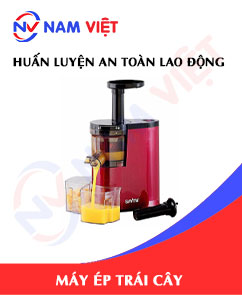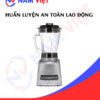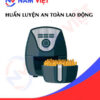Occupational Safety Training in Juicer Manufacturing
99,000 ₫
Note: The above price is calculated for one person, the price may fluctuate depending on the number of trainees participating in the course and market movements. For more accurate pricing support, please refer to the quotation table or contact our consulting staff directly.
Occupational safety is an important issue in juicer manufacturing factories and needs to be addressed promptly to ensure the health and safety of workers, while enhancing the reputation of businesses. The Occupational safety training course is one of the effective solutions to raise awareness of accident prevention for workers participating in juicer manufacturing.
Table of Contents
Toggle1. Overview of Juicer Machines
a. What is a Juicer Machine?
A juicer machine is an electronic or mechanical device used to extract juice from various types of fruits and vegetables. Juicer machines operate by crushing and pressing fruits using mechanical or electrical force to separate the juice from the food.
Juicer machines can be used to press fresh fruits or vegetables and are commonly used for manufacturing fresh fruit juice or as ingredients for packaged fruit juices. Juicer machines are frequently used in restaurants, eateries, food stores, or at home for daily production of fresh fruit juice for family use.
Some modern juicer machines are designed to preserve nutrients and enzymes in fruits, creating more flavorful and nutritious fresh juice. Additionally, some machines can also extract juice from vegetables such as carrots, spinach, radish, apples, oranges, lemons, etc., to produce juice or smoothies that support health.

b. Types of Machinery for Juicer Manufacturing
The machinery and equipment involved in the production and assembly of juicer machines include:
- Cutting, shaving, and boring machines: used to cut, shave, and bore juicer parts from materials such as steel, aluminum, copper, plastic, wood, etc.
- Lathes and milling machines: used to process internal components of juicer machines.
- Welding machines: used to weld parts together, forming machine frames or other components.
- Packing machines: used to package products after the manufacturing process is completed.
- Quality inspection equipment: used to inspect the quality of parts and products before assembly or shipment.
- CNC machines: used for precise and rapid processing of machine parts.
- Robots: used for assembly, quality inspection, or other tasks at the juicer manufacturing factory.
- Computer systems and software: used to control machinery and manage the manufacturing process.

c. Juicer Manufacturing Companies in Vietnam
There are many well-known juicer machine brands on the market, with some of the most popular and reputable brands being:
- Hurom: a juicer brand from South Korea, Hurom is one of the leading brands for juicer machines. Its products are highly rated for juicing efficiency, attractive design, and quality.
- Omega: a U.S.-based juicer brand known for high-end products with excellent juicing performance. Omega offers a range of juicer machines from basic models to advanced models with multiple features.
- Breville: an Australian brand providing a variety of juicer machines, from basic to high-end models with modern features.
- Philips: a famous juicer brand from the Netherlands, Philips provides quality products with optimized design and modern features.
- Cuisinart: a U.S. brand known for high-quality products, elegant design, and useful features.
- KitchenAid: a U.S. brand offering a range of high-quality juicer products with attractive designs and modern features.
d. Specific Jobs in a Juicer Manufacturing Factory
Group 1
- Executive director, deputy director, and department heads in a juicer manufacturing factory.
Group 2
- Safety officers: manage safety in the factory, design safety procedures, monitor and ensure employees comply with safe working practices.
Group 3
- Purchasing and warehouse management: responsible for ordering and managing materials and equipment necessary for juicer manufacturing.
- Production: the juicer manufacturing factory has production lines for assembly. Production staff perform tasks such as assembly, quality inspection, testing, and product packaging.
- Quality inspection: quality control departments inspect products to ensure they meet safety and quality standards.
- Maintenance and repair: maintenance teams ensure machinery and equipment are regularly serviced and repaired to maintain maximum performance and durability of manufactured products.
Group 4
- Office, service, sales, and marketing jobs.
- Production management, quality management, human resources management, material management, and financial accounting management.
- Design: the factory may have specialized design departments to develop new products and improve existing ones. Design staff create technical drawings and evaluate designs for feasibility and efficiency.

2. Overview of Occupational Safety Training for Juicer Manufacturing
In this article, we focus on issues related to Group 3, because Group 3 directly participates in the manufacturing process and faces the highest occupational safety risks. For reference on other groups, see here.
a. What is Group 3 Occupational Safety Training?
- Group 3 Occupational Safety Training consists of sessions that equip workers with awareness of workplace accident prevention.
- This safety training course helps workers identify and avoid hazards, reducing the risk of workplace accidents during manufacturing.
REGISTER FOR OCCUPATIONAL SAFETY TRAINING SERVICES
b. Training Duration
Initial Safety Training
- Total training time is at least 24 hours, including exam time.
- 8 hours of theory on policies and labor safety laws
- 8 hours of theory on basic labor safety and hygiene knowledge
- 4 hours of theory on specialized training content
- 2 hours of practical training on specialized content
- 2 hours of theoretical exam at the end of the course
The safety training center will divide the schedule into multiple sessions depending on workers’ availability. Typically, there are 6 sessions over 3 days, provided the manufacturing company can arrange continuous training.
Periodic Safety Training
- Before the occupational safety card expires, workers wishing to renew it must attend a periodic occupational safety training course, with periodic training time being at least 50% of the initial training duration.
Explanation: total periodic safety training time is at least 12 hours, including exam time. Upon completion and passing the exam, workers will have their occupational safety cards reissued and renewed.
c. Training Content
| No. | TRAINING CONTENT | TRAINING DURATION (HOURS) | |||
| Total | Including | ||||
| Theory | Practice | Exam | |||
| I | System of labor safety policies and laws | 8 | 8 | 0 | 0 |
| 1 | Overview of labor safety and hygiene legal documents. | 6 | 6 | ||
| 2 | Standards and technical regulations on labor safety and hygiene. | 1 | 1 | ||
| 3 | Specific regulations of government authorities on labor safety and hygiene when constructing, expanding, or renovating manufacturing facilities and handling equipment, materials, and substances with strict labor safety and hygiene requirements. | 1 | 1 | ||
| II | Basic knowledge of labor safety and hygiene | 8 | 8 | 0 | 0 |
| 1 | Basic knowledge of hazardous and harmful factors in the workplace. | 4 | 4 | ||
| 2 | Methods to improve working conditions. | 1 | 1 | ||
| 3 | Safety culture in production and business. | 1 | 1 | ||
| 4 | Rights and obligations of employers and employees; labor safety policies; functions and duties of safety and hygiene network personnel. | 1 | 1 | ||
| 5 | Labor safety regulations, signs, instructions, use of safety equipment and personal protective gear; first aid skills and occupational disease prevention. | 1 | 1 | ||
| III | Specialized training content | 6 | 4 | 2 | 0 |
| Comprehensive knowledge of machinery, equipment, and substances causing hazards; risk analysis, assessment, and management for labor safety and hygiene; safe work procedures with machinery, equipment, and substances with strict labor safety requirements. | 6 | 4 | 2 | ||
| IV | Final assessment of occupational safety training | 2 | 2 | 0 | 0 |
| Total | 24 | 22 | 2 | ||
See more training content of the 6 groups
d. Occupational Safety Card
After completing the occupational safety training and passing the exam, workers will be issued an occupational safety card (commonly referred to as the Group 3 occupational safety certificate).
The Group 3 safety card includes personal information such as full name, date of birth, job, and specific work environment. It also displays training duration, a red stamp, and signature confirming course completion.
According to Clause 2 of Article 24 of Decree 44/2016/ND-CP, there are two cases:
- If the employer and employee have a labor contract, the employer must sign, stamp, and certify the safety card for Group 3 trainees after completing the training from An Toan Nam Viet and passing the exam.
- If the worker is freelance or temporary and does not have a labor contract, the training organization must sign, stamp, and certify the safety card after the worker completes the training from An Toan Nam Viet and passes the exam.

3. Recognizing Hazards Affecting Workers in Juicer Manufacturing
During the manufacturing of juicers, workers may encounter various hazards. Below are some common hazards:
- Electrical hazards: Juicers operate on electricity, which can pose electrical risks to workers, especially when using electrical tools such as cutting knives, assembly tools, lights, and other electrical devices.
- Noise hazards: Juicers generate high noise levels during operation, particularly in continuous manufacturing environments. Noise can damage workers’ hearing.
- Air quality hazards: Juicer manufacturing can produce toxic substances and dust, affecting air quality within the factory.
- Food safety hazards: Juicer components can pose food safety risks, especially if these parts are not properly cleaned.
- Occupational accident hazards: During manufacturing, workers may experience accidents such as cuts, burns, or crushing injuries when handling sharp tools or heavy equipment.
4. Common Occupational Accidents in Juicer Manufacturing
Common occupational accidents for workers in juicer manufacturing include:
- Accidents using cutting, planing, or boring machines: Workers may get trapped, cut, scratched, or punctured while using machines to fabricate juicer components.
- Accidents using welding machines: Workers may get burned when welding components together.
- Accidents using lathe or milling machines: Workers may get trapped, cut, or scratched while processing internal components of juicers.
- Accidents during equipment assembly or transport: Workers may fall, slip, get punctured, or be crushed by heavy objects while assembling or moving equipment in the factory.
- Accidents during testing or quality inspection: Workers may experience electric shocks, burns, scratches, or punctures while testing or inspecting products.
- Accidents using robots: Workers may collide with or be crushed by robots used for assembly, quality control, or other tasks in the juicer manufacturing factory.

5. Safety Measures When Participating in Juicer Manufacturing
Safety measures when participating in juicer manufacturing include:
- Providing protective equipment: Workers should be provided with full personal protective equipment such as helmets, safety glasses, gloves, hats, safety shoes, and masks to ensure their health and safety.
- Professional training: Employees involved in manufacturing juicers should receive full training on production processes, machine and equipment use, and how to identify and handle dangerous situations.
- Controlling hazardous agents: Hazardous agents such as dust, toxic gases, and noise must be controlled to ensure a safe working environment.
- Periodic machine maintenance: Equipment and machines should be regularly inspected and maintained to ensure optimal performance and minimize accident risks.
- Strict supervision of production processes: Production management should strictly monitor manufacturing procedures to ensure compliance with occupational safety regulations.
- Improving occupational safety culture: Create a safe working environment and raise workers’ safety awareness, which is crucial to reducing occupational accidents.
- Regular workplace environmental monitoring in factories, collecting and analyzing harmful factors to adjust and reduce hazards, preventing occupational diseases for workers.
6. Benefits of Occupational Safety Training in Juicer Manufacturing
An Toan Nam Viet provides businesses with the following benefits upon completing occupational safety training courses in accordance with Decree 44/2016/ND – CP on Occupational Safety and Hygiene:
- Workers can recognize potential occupational hazards and take preventive measures to avoid accidents.
- Businesses can establish risk prevention measures in production, operation, and maintenance processes.
- Reduce costs associated with safety risks at work.
- Continuous production improves labor productivity and product quality.
- Compliance with occupational safety laws to avoid legal risks.
- Enhances reputation and professionalism, elevating the business brand.
An Toan Nam Viet training courses are solutions to prevent external hazards, helping individuals avoid injuries or more serious consequences, including death.
REGISTER FOR OCCUPATIONAL SAFETY TRAINING SERVICE
7. Customer Feedback After Completing Occupational Safety Training in Juicer Manufacturing
An Toan Nam Viet has many years of experience supporting businesses across Vietnam, particularly in the southern provinces. This responsibility is invaluable to us, which is why our Occupational Safety Training is continuously improving in professionalism. Positive feedback and suggestions from our partners drive An Toan Nam Viet’s growth. Below are some testimonials from our clients:
Bac Nam E&C Investment and Construction Joint Stock Company
“My first experience with An Toan Nam Viet was impressive due to the 24/7 support from the consulting team. The class organization was fast and convenient for our company. Thank you very much for Nam Viet’s service!”
Hoa Dat Construction and Trading Joint Stock Company
“Nam Viet’s service greatly helped us simplify occupational safety and complete safety documentation for our work process. The consulting team responded promptly to our inquiries. Five stars for Nam Viet.”
See more customer interviews after using services from An Toan Nam Viet
8. Occupational Safety Training Capacity of An Toan Nam Viet
An Toan Nam Viet is a reputable and quality center for occupational safety training in Vietnam. Our training sessions are continuously held at factories, workshops, or construction sites across the country (all 63 provinces in Vietnam).
REGISTER FOR OCCUPATIONAL SAFETY TRAINING SERVICE
Occupational safety training license
- An Toan Nam Viet has been inspected and certified by the Department of Safety under the Ministry of Labor – Invalids and Social Affairs and granted a certificate of eligibility for occupational safety and hygiene training. This further reinforces our training capacity.

Training materials and lectures
- Before being applied to occupational safety training courses, all materials are reviewed to ensure knowledge accuracy and effective application.
- The teaching methods of instructors follow An Toan Nam Viet standards, developed by experts in occupational safety and hygiene training to maximize knowledge retention for trainees.
Facilities
- Controlling classroom factors affecting training increases teaching efficiency and knowledge absorption for trainees.
- Our training support facilities provide spacious classrooms meeting standards for area, lighting, and training equipment.
9. Nationwide Reputable and Quality Safety Training Center
At An Toan Nam Viet, we prioritize professional dedication in occupational safety training. For us, imparting knowledge on self-protection to workers equips them with safety tools for their livelihood and contributes to nation-building.
To ensure effective training, we meticulously prepare all tools, teaching equipment, curricula, materials, sound, and lighting.
Our instructors are experts with years of experience in the field, including research projects on hazard identification across industries and prevention methods.
Lectures are based on practical experience and delivered in a lively, easy-to-understand manner for workers. Knowledge is always aligned with Decree 44/2016/ND-CP.
Workers learn hazard prevention methods and self-protection, applying them appropriately in real work situations.
Our training center proudly offers professional and reliable occupational safety training with advantages such as:
- Competitive training fees without compromising quality.
- Flexible training schedules suitable for company production.
- Fast and legal-compliant certification procedures for occupational safety training.
- Experienced and long-standing instructors.
- Classrooms controlled for factors affecting training efficiency and knowledge retention.
- Lectures tailored to occupational safety in businesses.
- An Toan Nam Viet works diligently and professionally to provide accurate and prompt customer support.

10. Additional References for Occupational Safety Training in Juicer Manufacturing
- Occupational Safety Training Materials Collection
- Occupational Safety Training Test Collection
- Occupational Safety Materials for Juicer Manufacturing
- Occupational Safety Training Curriculum for Juicer Manufacturing
- Occupational Safety Quiz for Juicer Manufacturing
1 review for Occupational Safety Training in Juicer Manufacturing
No comments yet















namchinh.haiphong341
Dịch vụ huấn luyện an toàn lao động rất tốt nhé!